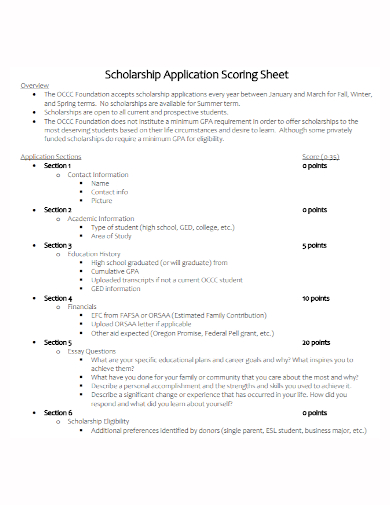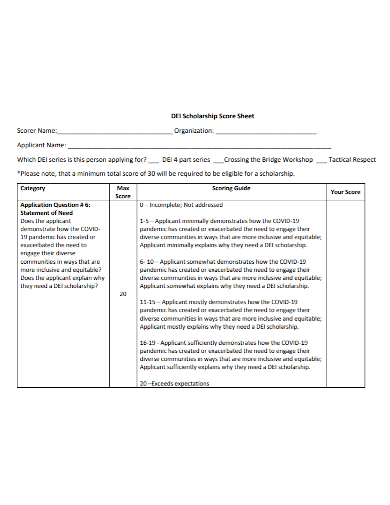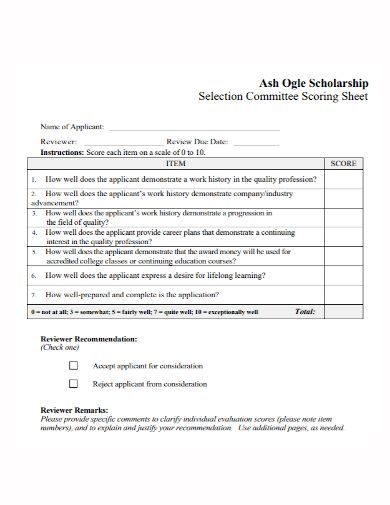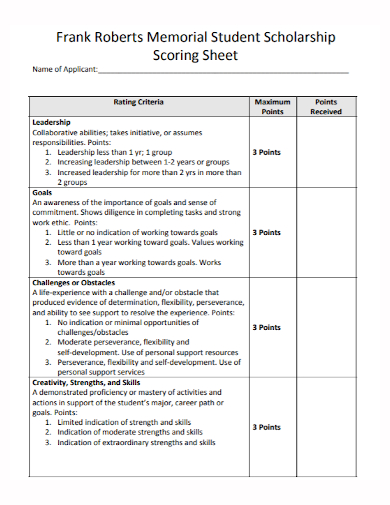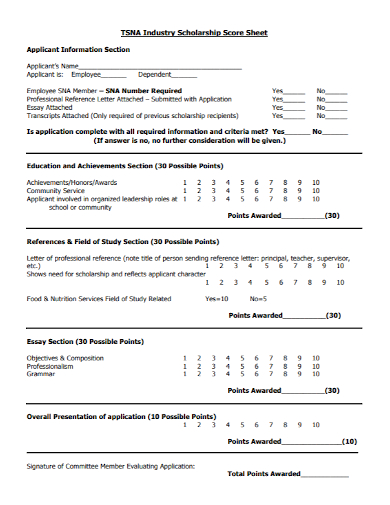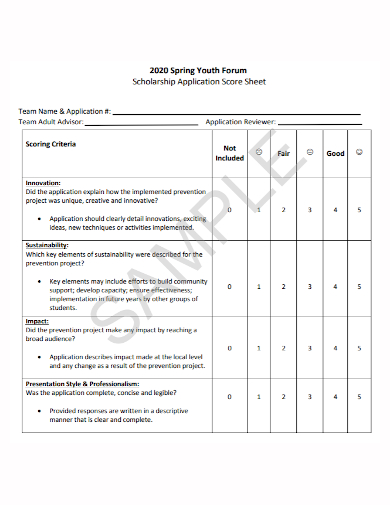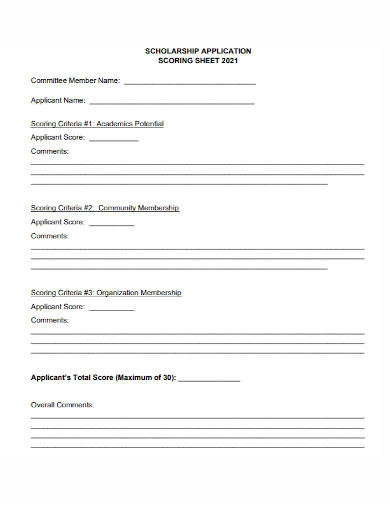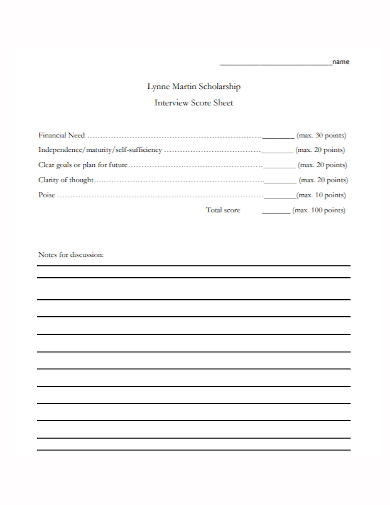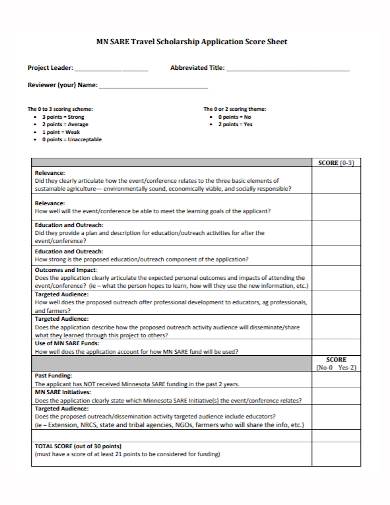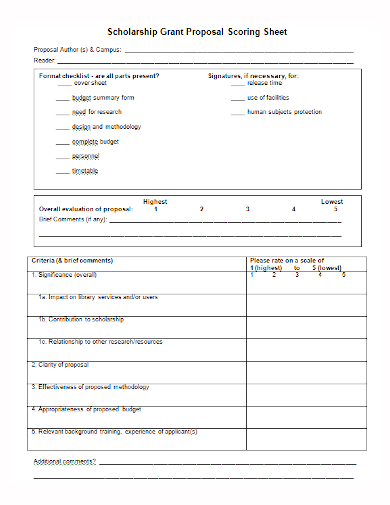10+ Scholarship Scoring Sheet Samples
The construction of a detailed rubric is the first stage in any sensible scholarship application procedure. Rubrics are step-by-step instructions for reading and scoring each application. When reviewing scholarship and fellowship applications, using rubrics helps reviewers stay consistent, reduces personal bias, and provides a handy reference for everyone involved. You may guarantee that all asked information is relevant and important by creating a rubric before designing your application. This saves time for both the candidates and your team. Need some help with creating your criteria for your scholarship application? We’ve got you covered! In this article, we provide you with free and ready-made samples of Scholarship Scoring Sheets in PDF and DOC format that you could use for your benefit. Keep on reading to find out more!
1. Scholarship Applicant Scoring Sheet
2. Scholarship Application Scoring Sheet
3. Organization Scholarship Scoring Sheet
4. Scholarship Committee Scoring Sheet
5. Student Scholarship Scoring Sheet
6. Industry Scholarship Score Sheet
7. Youth Scholarship Score Sheet
8. Scholarship Committee Member Scoring Sheet
9. Scholarship Interview Scoring Sheet
10. Travel Scholarship Scoring Sheet
11. Scholarship Grant Proposal Scoring Sheet
What is a Scholarship Scoring Sheet
Scholarship Scoring Sheets clarify how each application will be examined and assessed. When reviewing scholarship applications, using rubrics helps reviewers stay consistent, reduces personal bias, and provides a valuable reference for everyone involved. Rubrics are important for many types of assessment procedures and are most typically developed by teachers to measure student performance. You may guarantee that all asked information is relevant and important by creating a rubric before designing your application. By revealing the criteria in your rubric, you may set yourself apart from other institutions, build confidence with potential candidates, and make the entire process more open. Just make sure anything you’re sharing is easy to find and written in plain English.
How to make a a Scholarship Scoring Sheet
It’s a major benefit to share clear information about your evaluation criteria and schedule, and rubrics are a terrific method to achieve so. Everyone participating in your application process benefits from sharing the rubric’s core criteria for a successful application. A Scholarship Scoring Sheet Template can help provide you with the framework you need to ensure that you have a well-prepared and robust scoring sheet on hand. To do so, you can choose one of our excellent templates listed above. If you want to write it yourself, follow these steps below to guide you:
1. Define the objective of the score.
Consider how each component of your application should be evaluated. What would make an exceptional application? How thorough do you want your scoring to be? Should each component of the application be given its own score?
2. You can use either a holistic or analytic rubric.
In terms of fundamental distinctions, the holistic rubric is simpler to construct but provides less insight on individual strengths and shortcomings inside an application than an analytic rubric. An analytic rubric would use several scales and criteria to evaluate the GPA, references, and essay.
3. Create a rating scale.
Each component is identified for evaluation using these criteria. Although letter grades may be used, numeric scores are likely to be the most effective for application assessment. Most rating scales include 3-5 levels.
4. For each rating, provide a description.
The use of clear and consistent terminology will aid reviewers in making correct decisions. Concentrate on observations that can be precisely measured, such as the degree to which requirements are satisfied.
5. Complete the rubric.
Format your rubric for simple access and reference, then evaluate its usefulness, collect appropriate comments, and make any revisions. When it comes to reviewing scholarship and fellowship applications, rubrics should be updated on a regular basis—a rubric is only as useful as it is relevant to current goals.
FAQ
How does a scholarship program work?
Sometimes a scholarship is a one-time payout. Other scholarship grants are renewable; students get funding each academic year or semester for a few years or for the remainder of their studies.
Do you return scholarships?
Grants and scholarships are considered gift aid and do not need repayment. Grants are frequently given out by the federal government, states, or institutions, and are based on financial need.
What percentage of students apply for scholarships?
Scholarships are projected to be awarded to 7% of students. A full scholarship will be awarded to only 1.5 percent of students. Need-based scholarships totaled $8.8 billion.
Applicants can focus on preparing their application when they have access to assessment criteria. This is when score sheets come in handy. To help you get started, download our easily customizable and comprehensive samples of Scholarship Scoring Sheets today!
Related Posts
FREE 10+ Sample Interview Score Sheet
FREE 10+ Sample Bowling Score Sheet
FREE 10+ Sample Cricket Score Sheet
FREE 10+ Sample Softball Score Sheet
FREE 9+ Sample Baseball Score sheets
FREE 9+ Sample Yahtzee Score Sheet
FREE 8+ Sample Chess Score Sheet
FREE 7+ Phase 10 Score Sheet Templates
FREE 7+ Sample Hand and Foot Score Sheet
FREE 4+ Sample Cheerleading Tryout Score Sheet
FREE 15+ Score Sheet Samples
FREE 11+ Football Score Sheet Templates
FREE 10+ Hockey Score Sheet Templates
FREE 10+ Sample Bunco Score Sheets
FREE 10+ Cricket Score Sheet Samples


